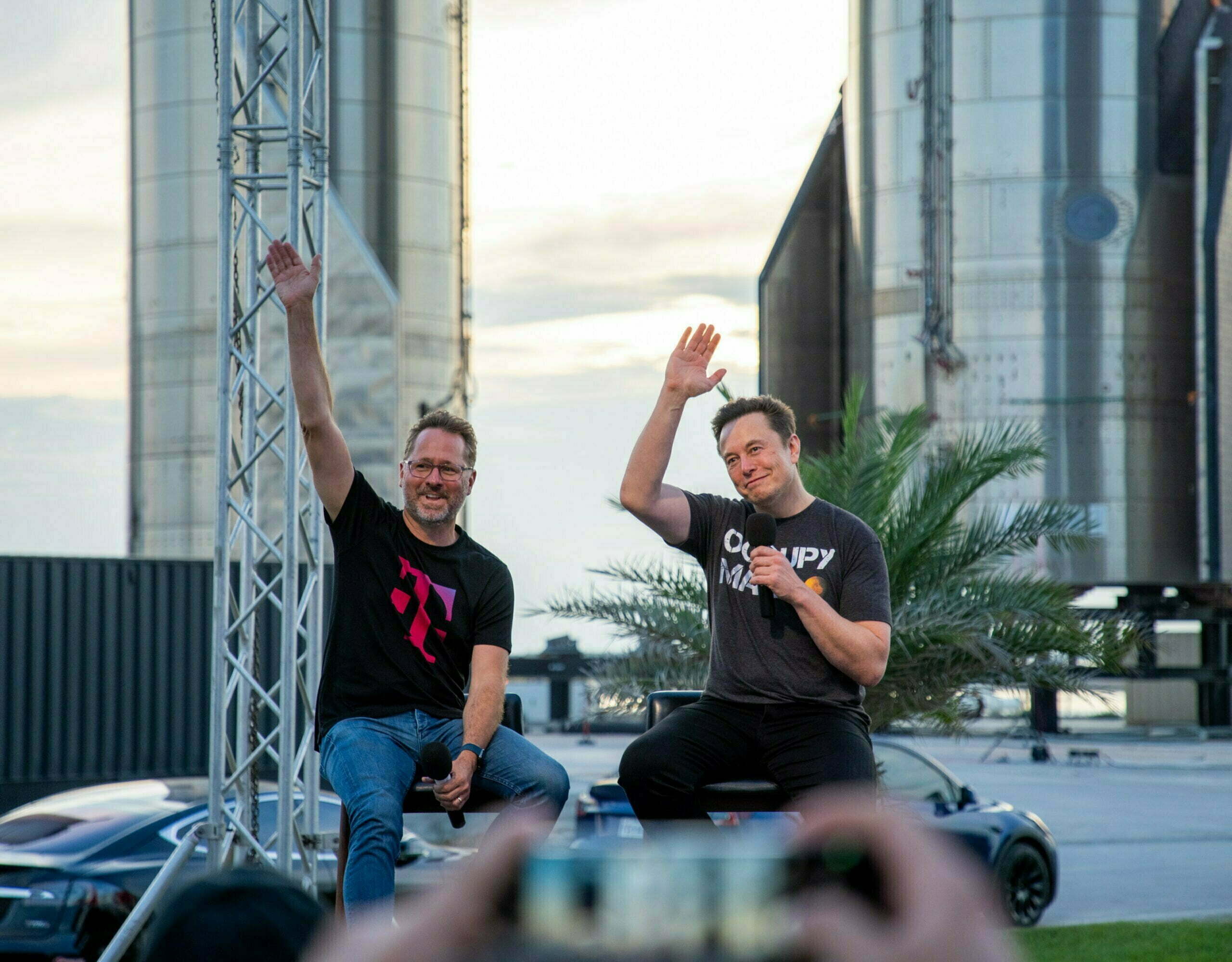Jealous AT&T tries to block T-Mobile’s Starlink Deal
In a classic case of corporate rivalry, AT&T has filed a complaint with the FCC to try to halt T-Mobile’s deal with SpaceX’s Starlink. T-Mobile, under the leadership of CEO Mike Sievert, wants to use the elon musk owned Starlink satellite internet to provide cellular connectivity to its customers, especially in rural areas and dead zones where terrestrial coverage is weak. The move by AT&T is seen as an attempt to prevent T-Mobile from gaining an edge in the cellular service market and maintain their dominance.
The T-Mobile and SpaceX Starlink Deal

What is the T-Mobile and SpaceX Starlink Deal?
The deal between T-Mobile and SpaceX’s Starlink satellite internet aims to provide reliable cellular connectivity to underserved areas, including rural communities and dead zones where coverage from cell towers is weak or nonexistent. T-Mobile has agreed to use SpaceX’s Starlink satellite internet to provide cellular connectivity to its customers.
Why did T-Mobile and SpaceX decide to make a Deal?
The deal was made to provide cellular service to areas that have poor terrestrial coverage. T-Mobile recognizes the need to expand coverage and ensure that their customers can stay connected even in remote areas. SpaceX has launched hundreds of low-orbit satellites to provide universal internet coverage, and this deal will help T-Mobile tap into that network to offer cellular connectivity.
What are the Benefits of the T-Mobile and SpaceX Starlink Deal?
The T-Mobile and SpaceX Starlink deal benefits customers living in remote, underserved areas that have traditionally been overlooked by cellular service providers. With this deal, T-Mobile can provide its customers with reliable cellular service, regardless of their location, which will help bridge the digital divide. Additionally, this deal will enable T-Mobile to expand its reach in the cellular service market and potentially gain an edge over its competitors, particularly AT&T, who has been threatened by T-Mobile’s growth.
The Satellite-Based Connectivity
How will Satellite-Based Connectivity Benefit T-Mobile?
Satellite-based connectivity will benefit T-Mobile by enabling the company to reach customers in underserved areas. T-Mobile has a massive dead zone problem in vast swaths of the United States, particularly in parts of Alaska, where traditional cellular towers have been unable to provide reliable coverage. Turning to alternative methods of connectivity like satellite-based connection allows cellular service providers like T-Mobile to beat its weakness and reach new customers in hard-to-reach areas.
What is the Role of FCC in Satellite-Based Connectivity?
The Federal Communications Commission (FCC) plays an essential role in regulating satellite-based connectivity providers and ensuring that they comply with regulations. The FCC has allowed companies like SpaceX to launch and manage low-earth-orbit satellites for providing internet access to remote parts of the country. The FCC also regulates the spectrum both communication providers use to ensure that they do not interfere with each other. Att claims that T-mobiles substitute for terrestrial coverage with satellite connectivity is not an authorized use of the spectrum. Though that argument should be taken with a mountain of salt as AT&T has a partnership to do the same thing
T-Mobile’s Dead Zones
What is a T-Mobile Dead Zone?
A T-Mobile Dead Zone is an area where there is no service or weak cellular coverage from a cell tower. T-Mobile has a massive dead zone problem across the United States, particularly in parts of Alaska, where traditional cellular towers have been unable to provide reliable coverage. These dead zones cause inconvenience and frustration for T-Mobile’s customers as they would likely experience lost calls or missed texts when in these areas.
How Will Starlink Help T-Mobile Overcome Dead Zones?
Starlink satellite internet can offer T-Mobile an alternative source of connectivity for its customers in dead zones. With access to SpaceX’s network of low-orbiting satellites, T-Mobile can ensure its users remain connected in areas where terrestrial connectivity is weak, thus helping the company to bridge the connectivity divide between urban and rural areas of the country.
What Are The Implications For Cellular Service Providers?
The implication that T-Mobile’s deal with SpaceX’s Starlink has for the cellular service provider is enormous. If successful, T-Mobile would have found an innovative way to supply cellular coverage to users with weak or no cellular signals, which could change the game and set the standard for connectivity in America. It could also lead to a challenge to the dominance of the traditional cellular service providers like AT&T and Verizon.
Satellite-to-Cellular Communication
What is Satellite-to-Cellular Communication?
Satellite-to-Cellular Communication is a kind of communication that enables internet and voice and data coverage from space using satellites. It can help provide cellular connectivity in areas where terrestrial cellular coverage is weak, such as remote and rural areas. we have previously written about it here. But to recap in areas such as the south west of the united states where its vast desert and no coverage this deal would spell the end of mobile dead zones as you would be able to use sms and other participating messaging apps to send messages to others.
How Will Satellite-to-Cellular Communication Impact T-Mobile?
Satellite-to-Cellular Communication can significantly impact T-Mobile by providing the company with a new source of connectivity to reach users in underserved areas. T-Mobile has made it a priority to expand its network and provide reliable connectivity to all its users, and this new method of communication can help achieve that goal. Furthermore, it would drastically change the carrier coverage maps that were all so familiar with. As the picture of terrestrial cellular service would show the entire USA as covered potentially unlocking hundreds of millions of dollars in grants for coverage that the FCC has tucked away. As long as a customer has a clear view of the sky then the satellite system constellation would provide the communication and backhaul to get your phone connected with the internet.

What Are the Advantages of Satellite-to-Cellular Communication?
The primary advantage of Satellite-to-Cellular Communication is that it can provide cellular connectivity in areas where traditional cell towers cannot reach. By using satellite connections to reach people in remote areas, T-Mobile and other carriers can expand their networks and provide customers in far-flung areas with reliable connectivity. This method of communication could revolutionize the way cellular service is provided, changing traditional coverage map bounadaries.
AT&T’s move to demand the FCC halt the arrangement until SpaceX and T-Mobile supply more technical details is seen as a desperate attempt to maintain their position in the market. Allowing T-Mobile to use SpaceX’s Starlink satellite internet to offer cellular connectivity would create a much more filled out coverage map and pose a threat to AT&T’s coverage. The move shows how beneficial the deal between Starlink and T-Mobile can be, both in terms of expanding internet access and setting the standard for connectivity in America.
